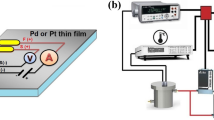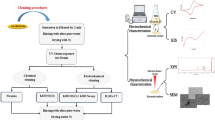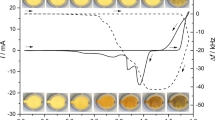Abstract
For primary pH measurements, a platinum hydrogen electrode and a silver chloride electrode are immersed in the same solution in a cell without transference (Harned cell). The platinum electrode is covered with dispersed platinum (platinum black) to increase the surface area. To determine the influence of specific deposition conditions (current density, duration, and composition of the electrolyte) on the properties of platinum black, the surface area, and the electrode performance, platinized platinum electrodes were investigated systematically using scanning electron microscopy and optical microscopy. Confocal laser scanning microscopy was applied to obtain quantitative information about roughness parameters. After assessment of the surface structures, improved conditions for the fabrication of platinized platinum electrodes were derived. It was found that all investigated electrochemically coated platinum electrodes obtained comparable values of standard potential of Ag/AgCl-electrodes within the measurement uncertainty. The platinum layer obtained by sputtering was significantly less distinct and less homogenous than the layer of platinum obtained by electrochemical deposition. The examinatio of shiny (uncoated) platinum electrodes evidenced a significant difference between multiple-used and freshly prepared platinum electrodes. Thus, uncoated platinum electrodes are not suitable for the Harned cell measurement either. Thus, to obtain reliable and reproducible results in pH measurements using the primary method, an electrochemical coating of the platinum electrodes under defined conditions is required.













Similar content being viewed by others
References
Vonau W, Guth U (2006) J Solid State Electrochem 10(9):746–752
Razmi H, Heidari H, Habibi E (2008) J Solid State Electrochem 12(12):1579–1587
Kahlert H (2008) J Solid State Electrochem 12(10):1255–1266
Alizadeh T, Jamshidi F (2015) J Solid State Electrochem 19(4):1053–1062
Buck RP, Rondinini S, Convington AK, Baucke FGK, Brett CMA, Camoes MF, Milton MJT, Mussini T, Naumann R, Pratt KW, Spitzer P, Wilson GS (2002) Pure Appl Chem 74(11):2169–2200
Spitzer P, Pratt KW (2011) J Solid State Electrochem 15(1):69–76
Bakos I (2000) J Solid State Electrochem 4:80–86
Forker W (1989) Elektrochemische Kinetik. Akademie-Verlag, Berlin
Brdicka R (1972) Grundlagen der physikalischen Chemie. VEB Deutscher Verlag der Wissenschaften, Berlin
Kortüm G (1957) Lehrbuch der Elektrochemie. Verlag Chemie GmbH, Weinheim/Bergstr
Greenwood NN, Earnshaw A (1990) Chemie der Elemente. VCH Verlagsgesellschaft mbH, Weinheim
Lehmann G (1948) Die Wasserstoffionen-Messung. Johann Ambrosius Barth Verlag, Leipzig
Hunt LB (1962) Platinum Metals Rev 6:150–152
Draves CZ, Herman VT (1925) J Am Chem Soc 47(5):1226–1230
Lorch AE (1934) Ind Eng Chem 6:164–165
Schwabe K (1976) pH-Messtechnik. Verlag Theodor Steinkopff, Dresden
Bates RG, Acree SF (1943) J Res Natl Bur Stand 30(2):129–155
Dickson AG (1987) J Chem Thermodynamics 19(9):993–1000
Bernard C (1970) Electrochim Acta 15(2):271–282
Klopsteg PE (1922) Ind Eng Chem 14(5):399–405
Clarke WF (1916) Dissertation. Johns Hopkins University, Baltimore
Mohn A (1906) Dissertation. Universität Zürich
Feltham AM, Spiro M (1971) Chem Rev 71(2):177–193
Hammett LP (1922) Dissertation. Columbia University, New York
Bates RG (1973) Determination of pH. Theory and practice. Wiley, New York
Galster H (1990) pH-Messung. Grundlagen, Methoden, Anwendungen, Geräte. VCH Verlagsgesellschaft mbH, Weinheim
Hamer WJ, Acree SF (1944) J Res Natl Bur Stand 33(2):87–103
Hollemann AF, Wiberg E (1958) Lehrbuch der anorganischen Chemie, 23. Auflage, Walter de Gruyter & Co., Berlin
Löffler F (2000) Design and production of the electric conductivity cell. In: PTB Bericht PTB-ThEx-15, 146. PTB-Seminar, Braunschweig, p 49–63
International Recommendation No. 54 (1981) pH scale for aqueous solutions. Organisation Internationale de Metrologie Legale (OIML)
Spitzer P, Wunderli S, Maksymiuk K, Michalska A, Kisiel A, Galus Z, Tauber G (2013) Reference electrodes for aqueous solutions. In: Inzelt G, Lewenstam A, Scholz F (eds) Handbook of reference electrodes. Springer-Verlag, Berlin Heidelberg, p 77–143
Hills GJ, Ives DJG (1951) J Chem Soc 305-310
Wagner W, Pruss A (2002) Phys Chem Ref Data 31(2):387–535
Gennero de Chialvo MR, Chialvo AC (2004) Phys Chem Chem Phys 6(15):4009–4017
Marković NM, Lucas CA, Climent V, Stamenković V, Ross PN (2000) Surf Sci 465(1-2):103–114
Binder H, Köhling A, Metzelthin K, Sandstede G, Schrecker ML (1968) Chemie-Ing Techn 40(12):586–591
Acknowledgements
We thank Mr. Steffen Weiß for conducting the actual magnetron sputter-coating.
Author information
Authors and Affiliations
Corresponding author
Electronic supplementary material
ESM 1
(DOC 55 kb)
Rights and permissions
About this article
Cite this article
Jehnert, D., Werner, B., Schiering, N. et al. The effect of platinum electrode surfaces on precise primary pH measurements. J Solid State Electrochem 23, 485–495 (2019). https://doi.org/10.1007/s10008-018-4144-3
Received:
Revised:
Accepted:
Published:
Issue Date:
DOI: https://doi.org/10.1007/s10008-018-4144-3




